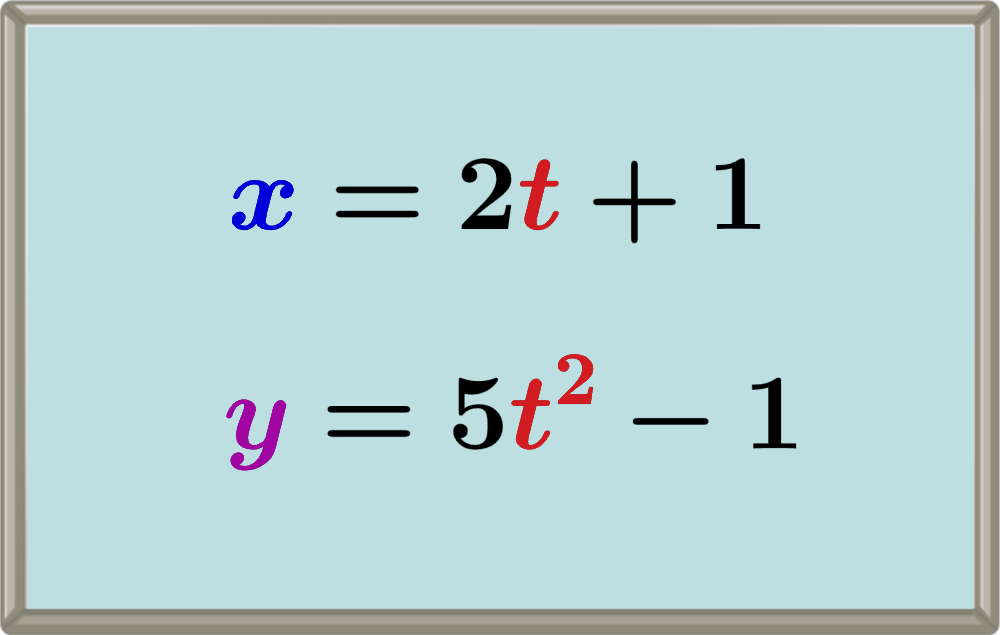The derivatives of parametric equations are found by deriving each equation with respect to t. Then, the chain rule is used to obtain a derivative of y with respect to x.
Here, we will learn how to find the derivatives of parametric equations. We will use several examples and practice problems.
Differentiation of parametric equations
Let’s learn how to find the derivatives of parametric equations using an example.
Consider the following parametric equations:
$latex x=t+1~~$ $latex ~~y=t^2$
When we derive $latex x$ with respect to $latex t$ and when we derive $latex y$ with respect to $latex t$, we have:
$latex \dfrac{dx}{dt}=1~~$ $latex ~~\dfrac{dy}{dt}=2t$
Using the chain rule, we can write as follows:
$$\frac{dy}{dx}=\frac{dy}{dt}\frac{dt}{dx}=\frac{\frac{dy}{dt}}{\frac{dx}{dt}}$$
Therefore, we have:
$$\frac{dy}{dx}=2t(1)=2t$$
Since we have $latex x=t+1$, we can write $latex t=x-1$ and the derivative is:
$$\frac{dy}{dx}=2t$$
$$\frac{dy}{dx}=2x-2$$
Parametric derivatives – Examples with answers
EXAMPLE 1
Find $latex \dfrac{dy}{dx}$ in terms of the parameter $latex t$ for:
$latex y=3t^2+2t$
$latex x=1-2t$
Solution
We start by finding the derivatives $latex \frac{dy}{dt}$ and $latex \frac{dx}{dt}$:
- When $latex y=3t^2+2t$, we have: $latex \dfrac{dy}{dt}=6t+2$
- When $latex x=1-2t$, we have: $latex \dfrac{dx}{dt}=-2$
Using the chain rule, we can write as follows:
$$ \frac{dy}{dx}=\frac{dy}{dt}\frac{dt}{dx}$$
$$=(6t+2)\left(-\frac{1}{2}\right)$$
$$ \frac{dy}{dx}=-3t-1$$
EXAMPLE 2
What is the derivative $latex \dfrac{dy}{dx}$ of the following equations? Write it in terms of the parameter $latex t$.
$latex y=(1+2t)^3$
$latex x=t^3$
Solution
Let’s find the derivatives $latex \frac{dy}{dt}$ and $latex \frac{dx}{dt}$:
- When $latex y=(1+2t)^3$, we have: $latex \dfrac{dy}{dt}=3(1+2t)^2(2)$. Then: $latex \dfrac{dy}{dt}=6(1+2t)^2$
- When $latex x=t^3$, we have : $latex \dfrac{dx}{dt}=3t^2$
With the chain rule, we have:
$$ \frac{dy}{dx}=\frac{dy}{dt}\frac{dt}{dx}$$
$$=6(1+2t)^2\times \frac{1}{3t^2}$$
$$ \frac{dy}{dx}=\frac{2(1+2t)^2}{t^2}$$
EXAMPLE 3
Find $latex \dfrac{dy}{dx}$ in terms of $latex t$ for the following equations:
$latex x=3t^4$
$latex y=2t^2-3$
Solution
We have to find the derivatives $latex \frac{dy}{dt}$ and $latex \frac{dx}{dt}$:
- When $latex y=2t^2-3$, we have: $latex \dfrac{dy}{dt}=4t$
- When $latex x=3t^4$, we have: $latex \dfrac{dx}{dt}=12t^3$
Now, we can use the chain rule to find $latex \dfrac{dy}{dx}$:
$$ \frac{dy}{dx}=\frac{dy}{dt}\frac{dt}{dx}$$
$$=4t\times \frac{1}{12t^3}$$
$$ \frac{dy}{dx}=\frac{1}{3t^2}$$
EXAMPLE 4
What is the derivative $latex \dfrac{dy}{dx}$ of the following equations? Write it in terms of $latex t$.
$latex x=2\sqrt{t}$
$latex y=5t-4$
Solution
We start by finding the derivatives $latex \frac{dy}{dt}$ and $latex \frac{dx}{dt}$:
- When $latex y=5t-4$, we have: $latex \dfrac{dy}{dt}=5$
- When $latex x=2\sqrt{t}=2t^{\frac{1}{2}}$, we have: $latex \dfrac{dx}{dt}=t^{-\frac{1}{2}}$
Now, we find $latex \dfrac{dy}{dx}$ using the chain rule:
$$ \frac{dy}{dx}=\frac{dy}{dt}\frac{dt}{dx}$$
$$=5\times \frac{1}{t^{-\frac{1}{2}}}$$
$$ \frac{dy}{dx}=5\sqrt{t}$$
EXAMPLE 5
Find the equation of the tangent line to the curve given parametrically by $latex x=\frac{2}{t}$ and $latex y=3t^2-1$ at the point (2, 2).
Solution
We can find the value of the parameter $latex t$ by substituting $latex x=2$, $latex y=2$ into the equations
$latex x=\dfrac{2}{t}~~$ $latex ~~y=3t^2-1$
This gives us $latex t=1$.
When differentiating parametrically, we have:
$latex \dfrac{dy}{dt}=6t~~$ $latex ~~\dfrac{dx}{dt}=-\dfrac{2}{t^2}$
When $latex t=1$, we have:
$$\frac{dy}{dx}\Big|_{t=1}=-3$$
This means that the slope of the tangent line is -3. Then, the equation of the tangent is of the form
$latex y=-3x+c$
Since the tangent line passes through the point (2, 2), we have:
$latex 2=-3(2)+c$
$latex c=8$
The equation of the tangent line is $latex y=-3x+8$.
EXAMPLE 6
Find the second derivative $latex \dfrac{d^2y}{dx^2}$ in terms of $latex t$ for the following parametric equations:
$latex x=t+1$
$latex y=t^3$
Solution
Differentiating each equation with respect to $latex t$, we have:
$latex \dfrac{dy}{dt}=1~~$ $latex ~~\dfrac{dy}{dt}=3t^2$
Using the chain rule, we have
$$\frac{dy}{dx}=\frac{dy}{dt} \frac{dt}{dx}=3t^2$$
Now, we derive each term of this equation with respect to $latex x$ to find the second derivative $latex \dfrac{d^2y}{dx^2}$:
$$\frac{d}{dx}\left( \frac{dy}{dx}\right)=\frac{d}{dx}(3t^2)$$
Since we cannot derive $latex 3t^2$ with respect to $latex x$, we use the chain rule:
$$\frac{d}{dx}(3t^2)=\frac{d}{dt}(3t^2) \frac{dt}{dx}$$
$$=6t \frac{dt}{dx}$$
Substituting this, we have:
$$\frac{d^2y}{dx^2}=6t \frac{dt}{dx}$$
Since $latex \frac{dx}{dt}=1$, we can write:
$$\frac{dx}{dt}=\frac{1}{\frac{dx}{dt}}=1$$
Then, the second derivative is:
$$\frac{d^2y}{dx^2}=6t (1)=6t$$
Parametric derivatives – Practice problems


The derivative $latex \frac{dy}{dx}$ in terms of t of the equations $latex x=4t(t-2)$ and $latex y=(t-1)^3$ is a fraction. What is the numerator?
Write the numerator in the input box.
See also
Interested in learning more about derivatives? You can look at these pages:




